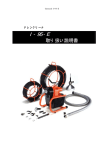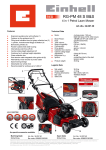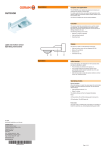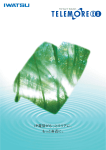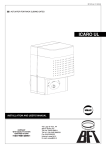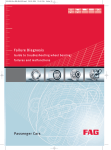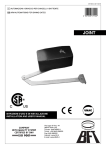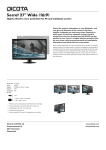Download USER MANUAL: PERMANENT MAGNETS ELECTRIC MOTORS
Transcript
USER MANUAL: PERMANENT MAGNETS ELECTRIC MOTORS 1. Generalities. The present manual refers to three types of electric motors designed and developed in ICPE Department 4: DC brushed permanent magnets motors hereinafter referred to as TM and TE, respectively; AC brushless permanent magnets motors hereinafter referred to as ACBL; DC brushless permanent magnets motors hereinafter referred to as DCBL. These electric motors are designed for the adjustable speed drives within the large range and, at the same time, they represent a solution to complex applications: semiconductor manufacturing process, terrestrial and aerospace actuating, guiding systems, etc. The adjustable speed drives represented a field in which the DC commutator brush electric motors held the supremacy, beacause of the simplicity with which the rotational speed could be adjusted in a very wide range and with special dynamic performances-it was practically the only solution for the high technology applications. At the same time, the performances imposed to the machine tools, industrial robots, aerospace applications: efficiency, heavy duty (inflammability, explosion, advanced vaccum), maintenance increased, the DC commutator brush electric motors proved to be ever less adequate. Within this context, it was necessary to remove the commutator-brushes subassembly and its function was taken over by very complex electronic architectures, as well as by position and /or speed inductive sliding contactfree tranducers. After the 1990s, the manufacturing costs of the inductive transducers and of the movement control electronic architectures decreased considerably in relation to the manufacturing costs of the DC electromagnetic excitation or permanent magnets electric motors, fact that finally imposed the acceptance of these drive systems on the market. ICPE Department 4 manufactures permanent magnets brushed and brushless electric motors in a bearing design, at a rated speed of 4000 min-1 and the rated torque of 1.9 Nm. On demand, there can be performed DCBL with other parameters or in a direct drive design. The transducers used are from the current production: resolver or tachogenerator. On demand, they can be delivered with Hall sensors or in the “sensorless” variant. The productmanufactoring is in accordance with the requirements: SR EN ISO 9001, SR EN ISO 14001, SR OH SAS 18001. 2. Mechanical configuration. The main components of TM and TE, respectively are the following: stator, rotor commutator-brushes subassembly, speed transducer and electromagnetic brake. According to Fig. 2.1, which shows a Fig.2.1 Cross section of the TM motor motor cross section, the rotor is made up of stamped laminations (ironsilicon) with alloted slots to which a DC winding is distributed. In the stator, there are distributed (SPM technology) permanent magnets - rare earths. The brake is of the permanent magnets electromagnetic type and the speed tranducer is of the analogical type – DC permanent magnets tachogenerator. The commutator-brushes subassembly has a classic design and is provided with two parallel current paths. ACBLs have a reverse mechanical configuration in relation to TM or TE, in the sense that the permanent magnets are distributed (SPM technology, or function the application of the IPM technology) to the rotor. The stator is made up of stamped laminations (iron-silicon), with alloted slots, to which a polyphase winding is distributed. The main characteristic of this type of electric motor is the lack of the commutator-brushes subassembly. Fig. 2.2 shows the motor cross section. The design is with Fig.2.2 Cross section of the ACBL motor bearings, and for the development of a motor heat constant as good as possible, the stator is free of housing. ACBL can be delivered in the variant with or without electromagnetic brake. The rotor position sensor is of the electromagnetic type – brushless resolver(from the internal output), of the photo-electronic (encoder) type; at the same time, it can be delivered without position sensor. DCBLs have the same mechanical construction as ACBLs. These motors are provided with the rotor position sensor of the magnetic type-the Hall sensor. On demand, the DC or AC brushless electric motors can also be offered in the direct drive design. 3. The operating principle of the permanent magnets electric motors. 3.1 DC commutator brush motor. In order to explain the operating principle of the DC brushed motor, one considers its simplest constructive variant consisting of a rectangular turn with the length l and the width 2r placed between the poles of a permanent magnet, Fig. 3.1.1. The considered turn can rotate freely around its rotational longitudinal axis, within the constant and uniform field of magnetic induction B, established between the magnetic poles N and S. The turn ends are connected to a DC source through a commutator-brushes subassembly forming a closed circuit. At the considered moment, the turn plane is coplanar to the magnetic induction direction. Beacause of the fixed position of the brushes P1 and P2, they will successively be in contact with the two lamellas of the commutator. The sliding contacts enable the current sense reversing through the turn when the turn plane is perpendicular to the magnetic induction direction. The electromagnetic torque generated by the motor is the result of the interaction between the induction field B and the electric current of intensity I passing through the turn. The force, acting on each conducting wire of l length at the considered moment, results from the composition of the elementary forces dF considered on the elements dl of the length of theconducting wires: dF = i dlxB Fig.3.1.1 The operating principle of the DC brushed motor The resultant force on a conducting wire of l length generates an electromagnetic torque whose expression is: M = Fxr In reality, a motor winding is made up of several turns distributed to the rotor lamination stack slots and their ends (terminals) are connected to the commutator lamellas on which the commutator brushes slide – their number being equal to the pole number of the motor (Fig. 3.1.2). Fig. 3.1.2 The rotor, commutator, shaft and brushes of a DC motor The electric current in the rotor turns changes its direction at each passing of the conducting wires close to the axis of the brushes (Fig.3.1.3). Consequently, the wave form of the rotor currents shows a time alternative variation of rectangular shape. Therefore, the piece that changes the direct current at the level of the motor terminals into alternative current at the level of the turns is the commutator. In case the DC motors are used as servomotors, there occurs the necessity of an accurate control of the speed at various loading levels of the motor, a rapid response to sudden variations of the load torque, respectively. Fig. 3.1.3 Path of lines of field and the direction of currents with the DC motor Thus, the DC servomotors differ from the DC classic motors in their oblong shape and the housing reduced diameter, a design that offers a reduced inertia moment of the rotor, fact that enables the increase of the useful torque necessary for the load acceleration (Fig. 3.1.4) Fig. 3.1.4. Examples of DC brushed servomotors 3.2 Brushless electric motor. In the case of these motors, the commutator-brushes subassembly (mechanical inverter) is replaced by an electronic inverter (electronic commutation). This design removes some disadvantages in comparison with the classic one, represented by the maintenance increased costs due to the commutator-brushes subassembly on the one hand and by the necessity of removing an important heat amount developed by the Joule effect in the rotor (an area difficult to cool) on the other hand. The brushless motor efficiency is superior (85%...90%) compared to that of the brushed motors, which is only (75%...80%). The brushless motor has the permanent magnets placed on the rotor surface, and the winding is distributed to the stator lamination stack slots; in this design, the Joule losses are removed easily. In order to exemplify the operating principle of the brushless motor, Fig. 3.2.1 shows four rotor-stator relative distinct positions for a two-pole motor, by specifying the stator currents. For simplification, the considered motor has a single-phase winding, the operating principle being the same as that of the real motor provided with a three-phase winding. Fig.3.2.1 Electromagnetic torque in case of a DC brushless motor The direction of the current through the winding is electronically reversed while passing from position 2 to position 3 of the rotor , from position 4 to position 1, respectively. The interaction between the rotor magnetic field and the stator current generates a torque which acts upon the conducting wires of the stator winding, having the same direction in the positions 1 and 3 and in the positions 2 and 4 it is null. It is obvious that the stator cannot rotate and, in accordance with the principle of action and reaction, there develops a counterclockwise torque over the rotor, putting it into action. The electromagnetic torque ripple is 100%, being unusable in many industrial applications. It is proved that, if the single-phase winding is replaced by a three-phase one, then the ripple decreases considerably.Fig. 3.2.2 shows brushless motors, designed for the low power applications from the output of ICPE SA Department 4. Fig. 3.2.2 Examples of brushless servomotors 4. Operating features. In general, the electric motors convert the electric power Pel (characterized through the current I and voltage U) into mechanical power Pmec (charecterized through the rotational speed n and the mechanical torque M developed in the motor shaft). The losses in the DC brushed / brushless motors are of the type PJ (in the windings) and losses in the magnetic circuit – PFe which, in general, have reduced values. 4.1 Electromechanical constant. The geometrical design of the magnetic circuit and of the windings shows the way in which the motor converts the electric energy into mechanical energy. The most important quantities are: the speed constant (kn) and the torque constant (kM). Thus, the speed constant represents the speed and the induced electromotive force (Uind) ratio and the torque constant represents the torque and the absorbed current ratio: n = knUind M = kMI the functions are strictly linear In general, with this type of motors, the diameter is much smaller than the axial length. 4.2 Steady state operation. Maximum continuous torque MC (MN), maximum permissible speed nmax (nN). From a mechanical viewpoint, the motor steady state operation can be at maximum continuous torque or at maximum permissible speed. The operation of the motors under these limits is stable and reliable . The inadmissible increase of these parameters causes the wear of the switching system and, finally, the motor premature failure. Fig. 4.2.1 shows the diagram of the motor maximum permissible steady state operation. Fig. 4.2.1 Maximum current IC, environment temperature T0 and winding maximum temperature T w. The absorbed current generates Joule losses while passing through the rotor winding which, function the heat delivery surface and the environment temperature - T0 [ºC], must be dissipated so that the winding temperature will not excced the maximum permissible value (insulation class) - T w [ºC] At the same time, the winding maximum temperature must be correlated to the mark of brushes. Hence, in the case of “copper-graphite” brushes, due to the fact that the winding cane bear a high current density, the rotor maximum temperature can be: 125ºC…155ºC. In the case of the “silver-graphite” brushes it cannot exced 85ºC. 4.3 Short time regime operation. Winding heat constant - τw. In some applications, for short periods of time, it is necessary to load or stress the motor over the values corresponding to the continuous rating. Thus, in the case of the short time regimes (intermittent), the rated current value can be exceeded. In general, the time for which the value of the current IC can be exceeded is about 60 seconds for motors with diameters: 60mm…90mm. Fig. 4.3.1 shows the ratio dependence: the operating current and the rated current (ION/IN) function the ratio [%] of the operating current (ON) to the motor rest time. In general, if the motor has a large cooling surface, the overload standing time increases. The exact calculation of the overload current depends on the rated current value and the environment temperature. 4.4 Operating dynamic regimes. The most important regimes are: the starting and the acceleration up to an imposed speed. These are performed at constant current/voltage. ee Fig. 4.3.1 Ratio of the maximum current to the rated one ION/IN function the loading degree Angular acceleration – α, inertia moment (of the rotor and of the load) – JR,s. Starting at constant current: the motor generates a constant torque to a constant acceleration and which a speed linear increase correspond, till the operating point is reached (Fig.4.3.2). Fig. 4.3.2 Starting at constant current – representation on the mechanical characteristic The angular acceleration is defined in the relation: kM I M α = 104 = 104 [rad/s2] (4.3.1) JR JS JR JS Load starting time: J JS Δt = ∙Δn∙ R [ms] (4.3.2) kM I 300 In the case of starting at constant voltage (Fig. 4.4.1), the torque increases from the torque value to the null speed MH , along the speed – torque linear characteristic, up to the rated torque MN . Fig. 4.4.1 Starting at constant voltage Speed – torque characteristic The bigger the torque is, the higher the acceleration will be.The acceleration decreases together with the speed increase and the speed increases slowly. This saturation of the the speed increase is described by the mechanical time constant in Fig. 4.4.2 and is defined by the following relation: JS J R J R τm = 100 R 2 , sau = τ,m = 100 R 2 1 , JR kM kM were: JS is the load inertia moment. In this case, the maximum acceleration is defined by the following relation: MH αmax = 104 JR JS Fig. 4.4.2 Saturation of the time speed increase for the starting at constant voltage The no – load starting time up to the operating point is: 1 Δt = = τ,m ∙ln 1 MP MR MR MP MR MR n0 n0 np 4.5 Operating point. In the case of the motor supply with the rated voltage UN and at the rated current IN, the operating point is shown in Fig. 4.5.1 Fig. 4.5.1 Establishing the operating rated point 4.6 Efficiency. If the motor is supplied in the conditions under item 4.5, then the efficiency is defined by the following relation: η= nN 30 .000 MN MR UN IN The maximum efficiency is calculated function the no – load current (I0), the starting current (IP) and is defined in the following relation: ηmax = 1 I0 IP 100 [%] 4.7 The heat time constant. The heat time constant represents the time necessary for the motor temperature to reach 63% of the final operating temperature. 4.8 Choosing the motor for accuracy drives. The way of choosing a low power motor or a servomotor depends on the application for which it will be used and the criteria are the following: The mechanical time constant and the torque value requested by the drive; Angular acceleration; Load inertia moment; Intermittent regime. Because of the fact that very often the application requirements do not comply with the motor rated characteristics, in which cases the speed multipliers are necessary and all the drive mechanical parameters must be related to the motor shaft. Other important factors: Other important factors: Motor overall size; Operating environment (temperature, humidity, explosion conditions, shocks and vibrations, etc); Maintenance period and costs; Efficiency. Taking into consideration the complexity of the conditions with which these electric motors shall comply, corresponding to the various types of electric drives, ICPE SA Department 4 ask the users for technical details concerning the application of these motors.











